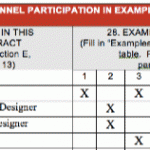 Cover letters are one of the most important pieces of a proposal. Unfortunately, 99% of the cover letters I’ve seen during my Brutally Honest Proposal Critiques are cr*p.
Cover letters are one of the most important pieces of a proposal. Unfortunately, 99% of the cover letters I’ve seen during my Brutally Honest Proposal Critiques are cr*p.
The problem stems from common misconceptions about the cover letter’s place in the current proposal environment.
Let us look at three misconceptions that can lead to epic cover letter failure.
Misconception #1: People Want To Read Your Cover Letter
Recently, I was at a pre-bid meeting at PASSHE, which is responsible for dorm construction for Pennsylvania’s state university system. The Director of Construction made it plain.
“Don’t include a cover letter in your proposal. It’s not going to convince us. So, don’t waste your time.”
Why would he say that?
He said that because he’s seen hundreds, if not thousands, of cover letters and they all said nothing.
There was nothing of value in those cover letters. Naturally, when he sees a cover letter, we have trained his brain to skip over it.
If you think someone is likely to read your cover letter, you are insane.
Instead, you have to give people a reason to read your cover letter. You have to get their attention and then create a “slippery slope” that will keep them reading.
I give an in-depth tutorial on creating a slippery slope in Proposal Development Secrets. Many of you have already read the book. I won’t rehash all of that.
But remember, you have to start off by creating a “knowledge gap.” You create a knowledge gap by highlighting a gap between what the reader knows and what the reader wants to know.
Let’s say you are proposing to a client that knows your firm pretty well. You might use, “3 Things You Might Not Know About ABC Architects.”
Those three things better be something they don’t know and also highlight what they would be missing out on if they hire someone else for this project.
You’ll notice I use this knowledge gap technique with a lot of my titles. That’s why my open rate is so much higher than the industry average. I give people a reason to read, then deliver.
Obviously, it’s a technique I’ve also used quite successfully in proposals to clients all over the country.
Misconception #2: You Can Use A Template
People always get angry at me when they ask for an example of a great cover letter for them to use. That’s because I tell them such a thing does not exist.
A great cover letter to the Department of Veterans Affairs is not going to be a great cover letter to the University of Pennsylvania Health System.
Each cover letter has to speak to the specific client and project. Unfortunately, that means, gasp, each cover letter will have to be written from scratch. There is no way around it.
Well, actually there is. Write a terrible cover letter they will simply skip over. But that won’t help you win.
Misconception #3: Throw Everything At Them and See What Sticks
This misconception leads to long cover letters. Here’s the problem.
If you had received a three-page letter in 1973, the likelihood that you would have read all three pages would have been very high.
But we live in a different world. When was the last time you read, word for word, a three-page letter?
Even better yet, when was the last time you even received a three-page letter?
I’m sorry to say that if my own grandmother sent me a three-page letter, she’d be pushing her luck. I couldn’t promise I’d read every word.
Busy people just don’t read long cover letters.
Anything longer than a page is pushing it. When my boss sees a two-page cover letter from me, his initial reaction is, “There is something up. Why is this so long?”
Two-page cover letters are sometimes unavoidable. But three-page cover letters are always avoidable.
Every word needs to earn its place in the cover letter. If it doesn’t speak specifically to this client, to this project…it hasn’t earned its place. As much as it pains you, leave it out.
Don’t let these misconceptions plague your cover letters. Follow my advice and you’ll get an opportunity to make a powerful pitch to your clients.
If you liked this article, please subscribe below or on the right side of the homepage. If you want to give us your thoughts on this issue, please leave a comment below.





Great post! Misconception #2 is spot on! It drives me nuts how many times I see the same generic letter over and over… Also, this template letter usually has everything in it (Misconception #3).
Travis,
Thank you for the comment.
I love reading cover letters that say “We’re excited to be submitting on project XYZ…” Yes – I can tell you are excited to be submitting… (in my best Ben Stein voice) That’s why your cover letter states it. Our it states you are passionate about the project. People who are passionate don’t have to write they are passionate – it shows in everything they do or write.
Another great post – worth passing along!
Thank you Kim!
Good reminders. This is similar advice to an SMPS speaker I saw at a regional conference. Here is where I struggle though. Any advice on helping BD staff get good project-specific, client-specific info to pack into proposals? Or to help find out what we offer that’s actually different? I’m the marketer who doesn’t interact with clients. All my info comes from BD and if I don’t get good info from them the entire proposal, not just the cover letter, reflects that. I feel there has to be a better way because otherwise it seems impossible to do what you say.
Liz,
Thank you for the comment. I’ll address this problem in a future post. Keep reading.
I do talk a little bit about this in my book. Pick that up if you haven’t yet. Here’s the link.
Amen!
Cover letters are a waste of everyone’s time.
Reuben,
I wouldn’t go that far. I certainly don’t think they are a waste of time. Not if you do it right.
I was once told by a US Army Corps of Engineers that when a proposal has a bound-in cover letter, the secretary rips the letter out of each copy before distributing them to the screening committee.
Bernie,
That’s a good story. I believe it. Years ago, I was on a debrief call where the Army Corps admitted to not reading most of our proposal.
I’m the only proposal writer at an engineering firm with nearly 20 project managers. All but a very small minority consistently rely on at least one of these three misconceptions – for every single cover letter. – thanks Matt.
Heather,
You might start by forwarding them the link to this article. Sometimes it helps to hear it from an outside source.
I’ve made everyone of those mistakes in cover letters, multiple times. As usual, you are spot on. Thanks Matt.
Jim,
Thank you for commenting. I didn’t even know you read the site. 🙂
I’ll shoot you an email.
Everything you are saying about the old way about writing cover letters is true. I hate having to follow what the uncreative people wrote before. Even though we win most of our bids, I would still like to write fresh and creative cover letters and proposals.
Maryann,
Thank you for commenting. Cover letters are just a piece of the puzzle. I’m sure many successful firms have terrible cover letters. Yet, they still win lots of contracts.
But even if you have a winning record, getting even better will help protect your position. It sounds like you agree.
Great post, Matt. I have been pushing people toward more concise and engaging letters for years and will keep fighting the good fight. When I have just a few minutes to ‘peer review’ a colleague’s proposal, I always go to the letter first. Whether read, skimmed, or glanced at, the letter remains part of the client’s first impression.
Thank you for your comment Jeff. Keep fighting the good fight.
This is a great piece, Matt. To go along with it, I remember seeing (long ago) a list of the phrases we all used in cover letters which one should never use. For example, the first item on the list was the traditional opening, “We are pleased to present.” The explanation was that if you weren’t pleased to present, you wouldn’t have presented at all, so these words were a waste of space. If someone could find that list again and share it, maybe we’d all learn even more about cover letters than you taught above.
Was it words not to use in your proposal? If so, I have that document.
When will we be able to turn off the broken record and stop having to repeat ourselves when we tell our folks in the field “quality, not quantity!?!” the Proposal Writer lamented, tapping dejectedly at her keyboard.
Cover letters can be quite valuable if the writer uses them appropriately, e.g., as a way to connect personally/remind the prospect of a recent meeting and to segue into the proposal with a friendly but professional recap of the reader’s needs and objectives (if the salesperson was lucky enough to have had an actual meeting or even phone call with the prospect ahead of time).
Nice choice of graphic. I like the oh-so-subtle hidden “hurdle” concept as a backdrop for the massive wipeout.
/A
Alicia,
Thank you for the comment.
Interesting reading – I was in a proposal training where it was stated in today’s world it is best practice to not include a cover letter as it has no value add. I’m old school and agree it is just good business practice and one should take the opportunity to make it of value.
Jackie,
Thank you for the comment.
Matt this is great. Thanks for giving voice to my frustration with template letters.
Beth,
Thank you for commenting.
Great post! I like your idea for “3 things you may not know about our company”.
I informally polled public works directors at a conference. 25 out 30 do not read cover letters. Of the 5 who did, it was a pass/fail test: was their name spelled correctly, were they talking about the right project. The remaining two said it set up their expectations for what they would reading the proposal – interesting or boring. By the way, those two were women and I’m still pondering what that might mean.
Great piece, Matt. “Please accept this letter as an expression of our genuine interest in your project!” Let that be the last time I write that!
There seems to be some pigeonholing of the idea of “templates” as a fill in the blank form. The cover letter templates we use are categorized to account for factors such as incumbency, and include prompts rather than fill-ins.